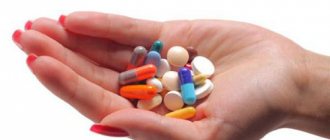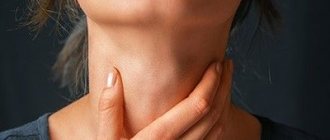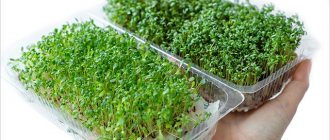Diet for hypothyroidism
The content of the article
Diet for hypothyroidism plays a very important role in therapeutic management. Hypothyroidism is a syndrome of symptoms that occurs as a result of a deficiency of thyroid hormones in the body. In order for the thyroid gland to produce and secrete hormones in the required quantities, it needs iodine.
This element is the main component of both thyroxine and triiodothyronine (thyroid hormones). If the cause of hypothyroidism is iodine deficiency, a diet rich in iodine is key to treatment. However, when treating hypothyroidism due to other causes, including thyroid dysfunction or inflammation, pharmacotherapy is necessary, but diet may increase its effectiveness.
Diet rich in iodine
Authorized Products
The list of permitted products, first of all, should include those that contain plant and animal protein: it is necessary for all metabolic processes, cell building and hormone synthesis. Products rich in tyrosine are especially welcome.
It is necessary to include iodine in large quantities in the diet: it is involved in the production of thyroid hormones. The daily diet should contain B vitamins: they also take part in the production of hormones, vitamin C: it strengthens vascular walls, linoleic acid and lipotropic substances: they help remove “bad” cholesterol from the body.
In addition, therapeutic nutrition for hypothyroidism should moderately stimulate the gastrointestinal tract, without causing overload and without causing gas formation, therefore, the introduction of foods rich in plant fiber and fermented milk products into the diet is indicated.
The list of recommended products includes:
- bread made from 1st and 2nd grade flour, yesterday's or dried, dry cookies;
- lean meat, “white” chicken meat containing tyrosine;
- low-fat varieties of sausages;
- fish, mainly sea (cod, mackerel, salmon), rich in phosphorus, polyunsaturated fatty acids and iodine;
- low-fat milk and lactic acid drinks, as well as cottage cheese, sour cream - in dishes;
- unsalted, low-fat and mild varieties of cheese;
- white omelettes, soft-boiled eggs, yolk with caution;
- porridges (buckwheat, millet, barley), casseroles and dishes made from them;
- fresh vegetable salads dressed with vegetable oil, vinaigrette, aspic;
- any fruits, especially persimmons, feijoas, kiwis, which are rich in iodine, as well as cherries, grapes, bananas, avocados;
- vegetables except for the cruciferous family, fresh herbs;
- horseradish and mayonnaise with caution;
- weakly brewed drinks (coffee and tea), tea with lemon or milk, freshly squeezed juices, rosehip and bran decoctions;
- Use butter with caution, vegetable oils - in dishes and when cooking;
- seafood (mussels, scallops, oysters, seaweed, rolls and sushi made from them).
What diet to use for hypothyroidism?
A diet for hypothyroidism should, first of all, be rich in iodine, which is necessary for the proper functioning of the thyroid gland.
About 70% of the iodine in the human body accumulates in the thyroid gland and allows it to produce and secrete thyroxine and triiodothyronine. For the normal functioning of the adult thyroid gland, it needs 150 mcg of iodine per day. In pregnant and lactating women, the need for iodine increases to 250 mcg/day.
Insufficient intake of this element will lead to a decrease in the production of thyroid hormones and, consequently, to an increase in the production of thyrotropin, a hormone secreted by the pituitary gland, which stimulates the secretory functions of the thyroid gland. Hypothyroidism can develop as a result of iodine deficiency, but it is worth remembering that the disease can also be caused by disorders in the thyroid gland itself or in the hypothalamic-pituitary system, which regulates the functioning of the thyroid gland.
Hypothalamic-pituitary system
A diet for hypothyroidism, in addition to iodine, should also contain a sufficient amount of selenium, which affects the absorption of iodine. Selenium deficiency can also lead to decreased concentrations of triiodothyronine (T3) in the blood.
Diet for a week
With hypothyroidism, it is allowed to eat most tasty and varied foods, so a diet for a patient for a week can be easily compiled. Every day the patient will eat the right healthy food, and if some foods do not suit his personal preferences, they can always be replaced with others. A sample weekly menu for patients with hypothyroidism might look like this:
- Monday. For breakfast, the patient is asked to eat muesli with skim milk, drink tea with stevia instead of sugar, and eat a sandwich of whole grain bread and low-fat cheese. For lunch you can offer a carrot salad, low-fat borscht cooked with veal, a glass of tea with a small slice of dark chocolate. Nuts or berries from the list of permitted ones are perfect as a snack. For dinner, the patient can be offered baked chicken or fish, and for dessert - baked pumpkin or apple.
- Tuesday. For breakfast, low-fat cottage cheese or a couple of chicken eggs with a salad of herbs and cucumbers, plus a sandwich with cheese, as on the previous day, are suitable. You can wash down your breakfast with kefir or yogurt. For lunch, it is suggested to eat stewed chicken or turkey with mashed potatoes and cucumber-tomato salad. Any acceptable fruit is offered for a snack. As a snack, the patient can eat boiled seafood or a sandwich made from whole grain bread and lean ham. For dinner there is a choice of cottage cheese or beef stroganoff, tea, bread and butter and 1 piece of fruit allowed.
- Wednesday. For breakfast, cottage cheese with nuts, whole grain bread with butter and kefir are served. For lunch, you can choose from boiled chicken or vegetable soup with lean meat, as well as kefir or tea with dark chocolate. As a snack, you can eat any low-fat dessert, fruit or sandwich. Dinner will require steamed fish with a side dish of wild rice, as well as freshly squeezed juice.
- Thursday. For breakfast, the patient should be offered 2 boiled farm eggs, seaweed salad and kefir or low-fat milk. For lunch, prepare a low-fat broth with chicken and eggs, herbs and carrot salad. You should wash down your lunch with green tea with stevia. For a snack, kiwi, nuts or a low-fat dessert are perfect. For dinner on Thursday you can have boiled chicken with a vegetable side dish or salad.
- Friday. For breakfast, you need to boil sea fish and serve it with a sandwich of whole grain bread, butter and low-fat cheese. You can wash it all down with freshly squeezed juice. For lunch, you need to eat boiled chicken with a vegetable salad or vegetable side dish, and choose an avocado for a snack. For dinner, a seaweed salad with stewed beef, washed down with tea and dark chocolate, would be good.
- Saturday. For breakfast, it is recommended to bake tomatoes with cheese and boil a couple of eggs, and you can wash it all down with juice, kefir or tea. The patient should have lunch with lentil soup, salad with apple and spinach. Fully low-fat fruit curd is suitable as a snack. For dinner on Saturday, you can cook any lean grilled meat, Korean salad and bake the permitted vegetables.
- Sunday. For breakfast, an omelet with Adyghe cheese and jelly is served. For lunch, try veal steak, vegetable salad or steamed vegetables. Pumpkin seeds or nuts are great snacks. For dinner, it is recommended to prepare mashed potatoes with herring or serve cottage cheese; you can wash down dinner with juice or tea with stevia.
It is important to remember that you can do a fasting day once a week. If the patient does not eat meat, then all meat products on the menu can be replaced with green buckwheat and tofu.
What to eat for hypothyroidism?
So what should you eat if you have hypothyroidism? Fish is an excellent source of iodine in the diet. Most of this element contains cod (100 mcg of iodine per 100 g), salmon (50 mcg / 100 g) and mackerel (45 mcg / 100 g). Iodine is also present in mineral water, but not in all its types, so you should keep an eye on the label when looking for this element.
Table salt is also a source of iodine, as many countries have passed legislation requiring salt manufacturers to iodize table salt. Selenium, in turn, is found in grain products, meat, fish, dairy products, eggs and vegetable sprouts.
Iodized table salt
In general, the diet for hypothyroidism should be properly balanced. Healthy protein should make up 15% of your daily energy needs, complex carbohydrates 55%, and fats 30% (with 20% unsaturated fatty acids and a maximum of 10% saturated fats).
Dietary fiber should be an important part of the diet because constipation is very common in patients suffering from hypothyroidism. It is recommended to consume 25-40 grams of dietary fiber per day.
Nutrition for thyroid disease
Nutrition for thyroid disease will depend on its function. Depending on the functional state, euthyroid goiter (without dysfunction), hyperthyroid goiter (increased function) and hypothyroid goiter (decreased function) are distinguished. To clarify the function of the gland, all patients are recommended to examine its hormones.
Most patients with nodes are in a euthyroid state, but over time, especially when a large amount of iodine with supplements enters the body, the production of hormones by autonomous formations (nodes) increases.
Most often, with an enlarged thyroid gland (diffuse toxic goiter) or with nodes in its tissue, there is an increased production of hormones and the phenomenon of thyrotoxicosis. At the same time, the level of basal metabolism in patients increases, and increased catabolism can cause weakness and muscle atrophy. Patients develop an insatiable appetite, they eat large amounts of food, but they look thin and emaciated. There is a loss of calcium and increased bone resorption, calcium appears in the urine, and a deficiency of vitamins, potassium and phosphorus also occurs. Patients experience irritability, increased excitability, increased blood pressure, and disturbed sleep.
Therefore, nutrition during an illness associated with thyrotoxicosis should be aimed at covering energy costs and restoring metabolic disorders. Patients with diffuse toxic goiter are shown enhanced nutrition and a diet of increased energy value is recommended by increasing the basic nutrients - proteins, fats and carbohydrates. The basic principles of nutrition are:
- Sufficient supply of vitamins and microelements (thiamine, retinol, calcium and phosphorus, potassium). The diet can be supplemented with vitamin and mineral complexes.
- Getting enough protein. Its average norm is 100 g for men and 90 g for women. But it is more correct to calculate the required amount of protein based on the weight deficit, and it can be 1.2-1.5 g per kg of weight.
- Increasing the energy value of food by increasing protein, carbohydrates and fats.
- A high-calorie diet is indicated for people with significant weight loss. Calorie content can reach 3000-3700 kcal, carbohydrate content increases to 400-550 g, fat - up to 120-130 g.
- Eating foods rich in calcium and phosphorus (dairy products).
- Fractional meals in small portions, avoiding feelings of hunger.
- Steam cooking, avoiding fried, spicy foods.
- Limit salt intake (5 g), as these patients tend to have high blood pressure.
- Exclusion of foods that stimulate the central nervous system (spices, strong broths, alcohol).
- To reduce extractive substances, meat and fish must be boiled and then subjected to further processing (stewing, frying).
- Products with a high caffeine content (coffee, strong tea, chocolate, cocoa) are also excluded.
- Limiting foods that cause fermentation (grapes, plums, kvass, apricots, peaches).
- For any form of nodular goiter, patients should consume more fresh fruits and vegetables (contain potassium), and cereals.
- It is recommended to switch to seafood (salmon, sea bass, saury, tuna, mussels, flounder, seaweed, shrimp, cod), lean beef and eggs. All sea fish, especially fatty varieties, contain omega-3 fatty acids, vitamins A, D and B, easily digestible proteins and essential amino acids. Sea fish replenishes the deficiency of calcium, magnesium, phosphorus and iron.
- Dairy products should be increased in the diet as a source of easily digestible fats, proteins and calcium.
A diet for thyroid disease, accompanied by a decrease in its function (hypothyroidism), on the contrary, should contain fewer calories and fats. It is aimed at losing weight and maintaining it at the same level, since with hypothyroidism, a lack of hormones leads to a slowdown in metabolism and weight gain. To lose weight, you need to limit: simple carbohydrates (baked goods made from white flour, pasta, honey, sweets, sugar, jam, confectionery); animal fats and introduce vegetable oils (linseed, corn, sunflower, sesame, olive) into the menu. Eliminate all fatty foods from the diet, including dairy and products with hidden fats (sausages, pates, processed meats). You should avoid fried foods.
Cooking foods without fat (steamed or baked) will help with weight loss, since the total calorie content of such dishes is reduced. The consumption of salt, spices and alcohol, which stimulate the appetite, as well as tea and coffee, is limited. For hypothyroidism, a diet is indicated that contains 70 g of protein and fat, 300 g of carbohydrates.
Diet:
Indications:
obesity as a primary disease or concomitant with other diseases that do not require special diets.
Destination purpose:
impact on metabolism to eliminate excess fat deposits.
General characteristics:
reducing the caloric content of the diet due to carbohydrates, especially easily digestible ones. and to a lesser extent - fats (mainly animal) with normal or slightly increased protein content. Restriction of free fluid, sodium chloride and appetite-stimulating foods and dishes. Increased dietary fiber content. Dishes are prepared boiled, stewed, baked. Fried, pureed and chopped products are undesirable. They use sugar substitutes for sweet dishes and drinks (xylitol and sorbitol are taken into account in the calorie content of the diet). The food temperature is normal.
Chemical composition and calorie content:
- carbohydrates - 300 g;
- proteins - 70-110 g (60% animals),
- fats -70-85 g (30% vegetable),
- calories - 1700-1800 kcal;
- sodium chloride (salt) - 5-6 g;
- free liquid - 1-1.2 l.
Diet:
5-6 times a day with enough volume to feel full.
Recommended and excluded foods and dishes:
soups Up to 250-300 g per serving. From various vegetables with a small addition of potatoes or cereals; cabbage soup, borscht, okroshka, beetroot soup. 2-3 times a week, soups in weak low-fat meat or fish broth with vegetables and meatballs.
Excludes: dairy, potato, cereal, legumes, pasta;
bread and flour products Rye and wheat bread made from wholemeal flour, protein-wheat and protein-bran bread - 100-150 g per day.
Excludes: products made from premium and 1st grade wheat flour, butter and puff pastry;
meat and poultry Up to 150 g per day. Low fatness beef, veal, rabbit, chickens. turkey, limited - lean pork and lamb - mostly boiled, as well as stewed; baked in large and small pieces. The meat is fried after boiling. Beef jelly. Beef sausages.
Exclude fatty meats, goose, duck, ham, sausages, boiled and smoked sausages, canned food;
fish Low-fat types up to 150-200 g per day. Boiled, baked, fried. Sea products.
Exclude: fatty species, salted, smoked, canned fish in oil, caviar;
dairy products Low-fat milk and fermented milk drinks. Sour cream - in dishes. Low-fat cottage cheese with 9% fat content (100-200 g per day) - natural and in the form of cheesecakes and puddings. Low-fat cheeses - limited.
Excludes: fatty cottage cheese, sweet cheeses, cream, sweet yogurt, fermented baked milk, baked milk, fatty and salty cheeses;
eggs 1-2 pieces per day. Hard-boiled, protein omelettes, omelettes with vegetables.
Excludes: fried;
cereals Limited for adding to vegetable soups. Crumbly porridges from buckwheat, pearl barley, and barley due to the reduction of bread.
Exclude: other cereals, especially rice, semolina and oatmeal, pasta, legumes;
vegetables They are used widely, in all forms, some of them always raw. All types of cabbage, fresh cucumbers, radishes, fresh herbs, zucchini, pumpkin, tomatoes, turnips are desirable. Sauerkraut - after washing.
Limit: dishes from potatoes, beets, green peas, carrots, rutabaga (total up to 200 g per day), as well as salted and pickled vegetables;
appetizers Salads from raw and pickled vegetables, vinaigrettes, vegetable salads with boiled meat and fish, seafood. Jellied fish or meat. Lean ham.
Exclude: fatty and spicy snacks;
fruits, sweet dishes, sweets Fruits and berries of sweet and sour varieties, raw and boiled. Jelly and mousses based on methylcellulose, xylitol, sorbitol. Unsweetened compotes.
Excludes: grapes, raisins, bananas, figs, dates, very sweet varieties of other fruits, sugar, confectionery, jam, honey, ice cream, jelly;
sauces and spices Tomato, red, white with vegetables, mild mushroom; vinegar.
Exclude: fatty and spicy sauces, mayonnaise, all spices;
drinks Tea, black coffee and coffee with milk. Low-sweet fruit, berry, vegetable juices.
Excludes: grape and other sweet juices, cocoa;
fats Butter (limited) and vegetable oils - in dishes.
Excludes: meat and cooking fats.
Sample menu.
First breakfast: vegetable salad with vegetable oil, low-fat cottage cheese, tea.
Second breakfast: fresh apples.
Lunch: vegetarian borscht with sour cream (half portion), boiled meat, stewed cabbage with vegetable oil, dried fruit compote without sugar (xylitol).
Afternoon snack: low-fat cottage cheese with milk.
Dinner: boiled fish, vegetable stew, tea.
At night: low-fat kefir.
Endocrinologist Demkiv Yu.V.
What should you not eat if you have hypothyroidism?
What should you not eat if you have hypothyroidism? Endocrinologists recommend limiting the consumption of foods containing sulfurocyanins and goitrogens. These substances inhibit the absorption of iodine and contribute to the development of goiter, that is, hypertrophy of the thyroid gland. Foods that cause goiter include:
- vegetables from the cabbage family - mainly cabbage, cauliflower, broccoli, turnips, rutabaga;
- legumes (soybeans);
- peanut;
- mustard;
- milk from silage-fed cows.
Signs of hyperthyroidism:
- Sudden weight loss;
- Mood swings;
- Insomnia;
- Nervousness;
- Protrusion of the eyeballs;
- Arrhythmia.
What's wrong with the thyroid gland? How to recognize and prevent illness in a child in time Read more
To identify gluten intolerance, you need to eliminate it for a month and then reintroduce it.
It is not recommended to remove gluten-containing foods from your diet before consulting a doctor, since its exclusion, despite temporary improvement, may subsequently cause an exacerbation and distort the results of the examination for diagnosis. Accurate diagnosis of celiac disease is possible only before starting a diet, and if a person is already on a diet, then serological blood tests and morphological analysis of the small intestinal mucosa will in most cases give a false negative result. All that remains is a blood test for genetic predisposition, but it can only give an answer to the question: “Is celiac disease possible?” The absence of the HLA-DQ2/DQ8 alleles typical for celiac disease in the genotype makes the development of the disease impossible. But a genetic predisposition is detected in 20-30% of people in the population, while celiac disease develops only in 1% of people.
In addition, it is not possible to independently distinguish celiac disease, gluten intolerance and wheat allergy; the diagnosis of these diseases is different.
Gluten-free diet provides remission of any autoimmune disease
Among alternative medicine specialists, the “autoimmune paleoprotocol” remains popular, which involves establishing specific nutritional principles for autoimmune diseases with the exclusion of gluten, dairy products, soy, mushrooms, beans, legumes, nuts and other products. According to these experts, such products disrupt the composition of the microflora and increase intestinal permeability. Instead, vegetables, fruits, game meat, organic and unprocessed meat are introduced into the diet. Such recommendations are not supported by sufficient scientific research and have a low level of evidence.
Drug treatment for some autoimmune diseases is complemented by dietary recommendations that can help alleviate the disease, but these must be selected in conjunction with your doctor. Even with celiac disease, other associated autoimmune diseases require separate treatment beyond just a gluten-free diet.
Bloating and abdominal pain are signs of gluten intolerance
Bloating and abdominal pain may be a sign of diseases associated with gluten sensitivity, but they are also a common symptom of diseases and functional disorders of the gastrointestinal tract caused by gluten.
- inflammatory processes;
- violation of the outflow of bile;
- insufficient production of digestive enzymes;
- infections;
- imbalance of intestinal microflora;
- lactose intolerance.
Many of these conditions are much more common than gluten sensitivity. Therefore, a consultation with a gastroenterologist and an examination can reveal the exact cause of abdominal pain.
Additionally, bloating and abdominal pain are not the only symptoms of celiac disease, gluten sensitivity, and wheat allergies. Each of these diseases has a number of its own special symptoms. Also in celiac disease there is a latent form, when there are no symptoms, and changes are present only in the intestines.
The main symptoms of celiac disease include:
- abdominal pain, flatulence, bloating, nausea;
- loose, unformed stools, diarrhea or constipation;
- weight loss, excessive thinness, difficulty gaining weight and muscle mass;
- overweight (recently, the disease has been increasingly detected in people with increased body weight);
- muscle weakness, loss of strength, headaches, joint pain, early osteoporosis;
- rash, dermatitis, psoriasis, dry skin, brittle nails, hair loss;
- menstrual irregularities, failure to carry a pregnancy to term, male and female infertility, decreased potency and libido, hormonal disorders;
- anemia, vitamin deficiency.
Symptoms for patients with gluten intolerance appear 4 or more hours after consuming gluten and include bloating and pain in the upper or lower abdomen, diarrhea or loose stools, and nausea. Other non-gastrointestinal symptoms include weakness, headache, depression, anxiety, joint or muscle pain, numbness in the legs or arms, itching during exercise or after a hot shower, and atopic dermatitis that does not respond to normal symptoms. treatment.
Wheat food allergy involves a rapid immune response within minutes, resulting in an allergic reaction in some people when consuming, contacting or inhaling foods containing wheat. The reaction occurs immediately after eating, is specific and can affect the skin, respiratory tract or gastrointestinal tract. Symptoms of a food allergy to wheat include abdominal pain, stomach cramps, vomiting, diarrhea, asthma, allergic rhinitis and conjunctivitis, rash accompanied by itchy skin and atopic dermatitis.
Cooking rules
For cooking, you need to choose only the right products and follow the advice of experts:
- use separate pots, pans, and cutting boards for cooking;
- cook only from approved products;
- make sure that wheat flour does not get into the patient’s dishes;
- Store gluten-free products separately in closed bags or containers.
By following these rules, you can avoid accidentally getting protein into ready-made dishes, because even a small amount of gluten causes an aggravation.







